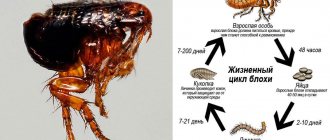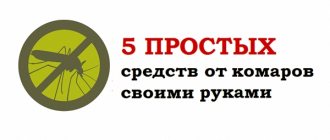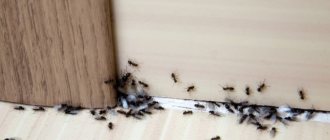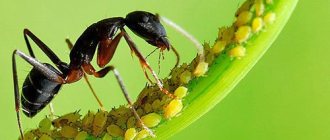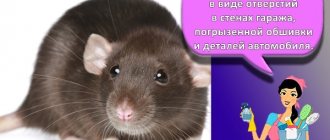Where do they come from?
There can be several options for the appearance of worms of different colors:
- A clothes moth larva (actually a butterfly caterpillar with microscopic limbs). You can usually find them in underwear that has been in the closet for a long time.
- The larvae of the carpet beetle (carpet beetle) are brownish, with protruding fibers.
- The larvae of the beetle grinder (lives in furniture made of wood) are white and quite large. But they can only get into bed by accident and in single quantities.
- Flea larvae are very small and harmless to humans. They are rare.
- Fly larvae (in summer, if there is spoiled food lying around).
Basically, their appearance is random. You can get rid of them by shaking out the contents of the closet, washing them, and using disinfectants (they can be purchased in pharmacies and stores).
If after cleaning the worms appear again, this is a reason to sound the alarm, since you are dealing with pinworms .
Where do skin beetles live in an apartment? How to find these beetles?
Adult beetles fly around the apartment and can unexpectedly and loudly “fly into someone’s forehead” without calculating their flight path. Until this happens, it is better to be the first to find those who replenish their fat reserves by destroying valuable materials. The beetle prefers warm, dry places; they can often be found near a radiator, on a windowsill, in a closet drawer, as well as under carpets, in and near sofas, in mattresses, etc. Skin beetles are often seen in the kitchen; for example, many people find beetles with their legs upside down on the kitchen stove.
There can be much more beetles than it might seem at first glance, because most of them are hidden from human eyes in the form of larvae that have gnawed into the substrate, which are actually engaged in sabotage of valuable materials, products, etc. Until you find out what attracts beetles to your home, it will be impossible to localize the source of their spread.
Carefully inspect your sofa, especially its upholstery, from all sides. This place is the most frequent stronghold of skin beetle larvae.
It also happens that there is simply no specific outbreak - clothes in closets, contaminated cereals, etc. For example, carpet beetles choose hard-to-reach places from which dust and dirt are rarely swept away, or where they accumulate most quickly. The larvae of these beetles feed on a layer of dust, small pieces of various materials - paper, carpet lint, hair and various organic debris. This kind of residue appears in any apartment within a couple of days after cleaning, under cabinets, beds, etc. (even if no one lives in it).
“Where do skin beetle larvae most often like to settle? Under the baseboards. Trite? Maybe, but sometimes there’s just nowhere for them to hide like underneath.”
Adult Smirnov's skin beetles, as a rule, crawl onto windows and lamps; they can be found between window frames or inside lamp shades.
What is pinworm
The pinworm is a roundworm that parasitizes the human body and is a type of nematode . Both humans and great apes suffer from these parasites (helminths). The disease they cause is called enterobiasis . Both children (mostly) and adults are susceptible to it.
The body of the worm is round in cross-section, up to 1.5 cm , grayish or white in color, tapering towards the ends. The worms live mainly in the small intestine (in the cecum they can cause appendicitis), and the individuals are dioecious.
Danger to humans
The harmful effects on the body are expressed as follows:
- Pinworms contribute to the intoxication of the body with toxic secretions. This causes disturbances in the functioning of the gastrointestinal tract (GIT), expressed in disorders and rapid fatigue of the patient.
- During reproduction, pinworms cause severe skin irritation in the anus and groin area. Itching forces you to scratch these areas until the skin is damaged.
- In its advanced stage, enterobiasis causes severe diseases of internal organs.
These are the most acute forms of harm. There is also a psychological everyday factor, expressed in the attitude of others towards the infected person.
Factors of infection
Basically, worm infestation (helminthiasis) occurs when:
- Failure to comply with hygiene rules (dirty hands, unwashed fruits and vegetables, violations of sanitary requirements when storing food).
- There are an abundance of flies that carry parasite eggs.
- Inattentive care of pets.
- Inadequate sanitization of premises where infected people are located.
- Unprotected contact with affected skin areas.
The main threat to everyone is a person infected with parasites. Within 4-7 hours, the eggs laid by pinworms become infectious and dangerous.
If they get on household items, clothing, bedding, or in food, they can cause infection to other people . Due to their microscopic size, they cannot be noticed without the appropriate technical equipment.
Numerous studies confirm that large numbers of pinworm eggs are found in public toilets.
The listed factors indicate that children are the first to fall into the risk zone of infection. How to accurately identify a disease at an early stage is a very serious question.
How to get rid of skin beetles in the house?
Because the beetles are invisible in their early stages and reproduce quickly, people often have to use insecticides. It should be borne in mind that the main cause of infection is deterioration of living conditions (lower temperature, increased humidity or lack of food). Therefore, skin beetles move into apartments and houses or settle closer to winter. Sometimes skin beetles find their way into human habitation even in favorable weather. Entry usually occurs through an open window or door. There is always a possibility of purchasing contaminated products and items. When identifying and fighting a pest, it is important to know the places where it can hide:
- carpets;
- cushioned furniture;
- cabinets;
- peeling wallpaper;
- mattresses;
- bags or packages with cereals, dry herbs;
- leather, wool and fur clothing that is rarely used;
- skirting boards.
Not only adults hide in dark places, but also their larvae, which pose the greatest threat. Most often, these beetles avoid the bathroom due to high humidity. The main habitat of skin beetles in an apartment is usually the kitchen or closet with clothes and shoes.
Chemicals
The fastest and most effective option to get rid of skin beetles with additional preventive effects. However, insecticides should not be used in certain situations because they can be dangerous to people. Particular care must be taken in the presence of children, people with hypersensitivity and pets. When choosing, you should take into account the characteristics of the drug.
Products related to the following types of exposure are effective against skin beetles:
- Wet disinfection. This option is one of the most popular. Such insecticides are powders that must be mixed with water. The resulting solution is applied in places where pests accumulate. The advantages of this method are ease of use and high efficiency. Some solutions are suitable for killing eggs. It must be taken into account that during treatment all people and animals must leave the treated area.
- Aerosol disinfection. A common type that is considered the easiest to use. Such products are sold in the form of sprays and aerosols, which differ in the area of distribution of the drug. Most drugs are effective only against a small number of pests. Such insecticides rarely affect insect eggs. If safety rules are not followed, there is a high risk of poison getting into the respiratory tract.
- Gas disinfestation. A less popular method that requires a special device that heats the poison and causes it to evaporate. The advantages of this option are large area coverage, accessibility and, in most cases, less toxicity. However, the gas type has lower efficiency and speed of action, and also requires the presence of electricity. It is desirable that the device be located near the place where beetles accumulate, but this is not always possible.
If there are a large number of cracks, cracks and other coverings, powders (dusts) can be effective. However, most of them are more toxic and cannot be used in residential areas.
It is important to know that the carpet beetle is not very sensitive to the effects of insecticides when compared to many other pests. Younger larvae are the most sensitive, so in the fight against insects the emphasis is on this stage of development. Repellents (repellent drugs) do not allow you to get rid of skin beetles; they are useless against this beetle even as a preventive measure.
The most effective insecticides are the following:
- Cypermethrin;
- Delta Dust Multi Use Pest Control Insecticide Dust;
- Raptor;
- Dichlorvos;
- Executioner;
- Digital;
- Althecid;
- Harris Boric Acid Roach Powder With Lure;
- Phoxide;
- Varan Molemore;
- Delicia Contra Insect;
- Reid;
- Tetrix;
- Clean house.
It is believed that permethrin-based insecticides are the most effective. Many ready-made traps are produced, created specifically for several types of insects, which allow you to get rid of skin beetles, including. An example of such a trap is the Pro Pest Pantry Moth & Beetle Traps 2 Pre-Baited Traps. However, such funds can only be used as a supplement.
Traditional methods
If skin beetles in the apartment have not yet managed to create a huge colony, then such products can be no less effective than chemicals. Most traditional methods are safe, accessible and low cost. The most effective options are:
- Boric acid. It is harmless to people and has no pungent odor. It stands out among other methods due to its high efficiency. Regular boric acid powder, which can be purchased at a pharmacy or hardware store, is suitable for processing. Boric acid should be applied to areas where pests accumulate and all places where they could hide.
- Vinegar. It must be mixed with water to obtain a safe solution (for 1 tablespoon of vinegar, add 1 liter of boiling water). For processing you need a spray bottle. The product should be used to treat all cracks, baseboards, dark corners and other places where beetles accumulate.
- Essential oil. Various herbs are suitable, but wormwood and lavender are considered the most effective. This option is completely safe. However, it is less effective because it has an exclusively deterrent effect. Often, cotton pads are used for this method; they are generously moistened with oil and placed in places where insects accumulate.
Freezing out pests is effective. They die at temperatures below 10°C. Please note that it is necessary to maintain a low temperature for at least 4 hours. The result directly depends on the duration of the procedure.
A regular vacuum cleaner can also help remove some of the skin beetles. Just be sure to dispose of the pests from the dust bag so they don't come back.
Prevention
An important point in the fight against skin beetles is preventive measures. Without them, the likelihood of re-infestation increases markedly even when using insecticides. Prevention consists of creating conditions unfavorable for pests. To avoid the reappearance of skin beetles, you must follow several rules:
- frequently carry out wet cleaning;
- Clean carpets weekly with a vacuum cleaner;
- install mosquito nets on windows;
- periodically check leather, fur and wool products for the presence of pests;
- store all cereals in glass containers;
- suitcases, bags made of leather and suede should be disinfected with boric acid once a year;
- throw away all unnecessary things;
- in closets with clothes and shoes, place dried herbs or cotton pads with essential oils (wormwood, tansy, lavender and lemon balm are suitable);
- ensure that there are no cracks in the walls, floors, window openings and window sills;
It is recommended to occasionally wash floors with a vinegar solution. It should be borne in mind that all things that are rarely used are especially susceptible to infection. Therefore, it is better to store products intended for long-term storage, as well as clothing, in covers or plastic bags.
Treatment Options
If the diagnosis is confirmed, treatment should begin immediately. For adults and children, the methods are similar, but have their own characteristics:
- For adult patients, procedures can be performed at home with the help of medications. The most effective drugs: vermox , mebex , helmitox , nemozol (use after consulting a doctor). Drug treatment should be combined with preventive measures (sterilization of linen, cleaning, sanitation) and diet (laxatives, foods that are easy on the stomach). It is advisable to repeat the course of treatment after 10-14 days. To relieve the itching sensation, antiallergenic drugs (suprastin, cetrin) are suitable.
- Children are most susceptible to the disease, so you need to be very careful when symptoms appear in order to take timely action. If they appear, you should immediately contact a medical facility. Delay can have a serious impact on the health and development of the child. Treatment, in general, is no different, but the dosage of medications and the conditions for keeping the patient are different.
In young girls, pinworm infection may be accompanied by urinary incontinence.
There are folk remedies that help expel worms (pinworms):
- Pumpkin seeds are a centuries-old remedy. Microelements and their combinations contained in pumpkin seeds, as well as substances formed during digestion, are intolerable to parasites.
- Another proven remedy is garlic . But it must be used taking into account the condition of the patient’s gastrointestinal tract (excluded in case of gastritis and ulcers).
But simple preventive measures will help prevent the disease.
Worms appeared in the apartment
If worms appear in the apartment, the entire algorithm for solving this problem can be constructed approximately as follows.
- Try to identify exactly whose larvae you found.
- Vacuum the parasites into a separate garbage bag and dispose of it immediately.
- Check all areas of the house similar to where you found the larvae for insect infestation.
- Carry out a general cleaning of the house using household chemicals.
- You can try to solve the problem yourself by poisoning the larvae with insecticides against crawling and flying insects.
- If you don’t want to do anything yourself or you were unable to solve the problem yourself, order the treatment of the entire apartment at the SES.
- After the treatment, after the period specified by the exterminators or the instructions for using the insecticide, carry out general cleaning again.
Worms in the apartment: photo
What the larva looks like depends on what species the insect belongs to.
- In different types of flies, the larvae may look like small worms of off-white, beige, copper, brown or almost black color, ranging from 0.2 millimeters to 1.5 centimeters in length.
- Mealworm larvae are yellowish in color and can reach 2.5-3 centimeters in length.
- Carpet beetles at the larval stage are brown, spindle-shaped, beige in color with a head of a darker shade, ranging in size from 1.5 to 2 millimeters.
- Bark beetle larvae can be large, up to 6 millimeters in length, the body is divided into segments, and the color is dirty white.
- Small white worms may well turn out to be moth larvae; their size does not exceed 5-7 millimeters.
The larvae of black and red cockroaches, bedbugs and various types of lice are smaller copies of adults with minor physiological differences, so the worm-like larvae have nothing to do with them.
In order to accurately determine the offspring of which insects you have found, you will have to check each parasite that makes you suspicious and look at what its larvae look like. If you find worms in your apartment, photos of different types of larvae will help you understand exactly what you are dealing with.
How to get rid of it?
When you see a skin beetle, it is better not to pick it up with your hands. If contact cannot be avoided, it is recommended to treat the affected area of the body with hydrogen peroxide or alcohol to minimize harm. The pest is afraid of sub-zero temperatures, the smell of wormwood and chemicals.
In the apartment, beetles hide in cracks. If a pest is detected, walls and cabinets 1.5 m high must be treated with boric acid. While working, you must use rubber gloves. To prevent the appearance of parasites in the house, experts recommend inspecting cabinets twice a year.
The main reason for the appearance of skin beetles in an apartment is poor hygiene and inattention to cleanliness. Following simple rules will prevent pest invasions:
- Mosquito nets should be installed on windows and doors.
- Clothes made from natural fabric and fur items should be packed in special bags for storage.
- Place food and cereals in containers with airtight lids.
- Seal all cracks in the floor and treat the garbage disposal with insecticide.
- Treat pets with insecticides against insects.
- Wash the laundry, wash the floor with a disinfectant, and clean the carpet using hot steam.
- Throw away or burn all food and things damaged by beetle larvae.
To kill insects in an apartment, you can use contact insecticides (Morimol, Difox, Supronit, Mittox) or preparations in the form of plates and tablets (Molemor, Antimol, Nimol). Aerosols are used to clean things and furniture. When fighting parasites, wear personal protective equipment - gloves and a mask.
You can put Antimol-contact tablets in the cabinet, 3-4 pieces are enough. on one shelf. The drug is placed on top of clothing, since the active toxic substance is heavier than air. People with allergies need to use this method carefully so that the disease does not worsen. Repellents are used to repel insects for a short time. If you are unsuccessful in fighting on your own, you should contact a professional pest control service.
Worms in the apartment: how to get rid of them
Very often, next to the larvae or somewhere else in the apartment, you can find adult individuals, from which it is much easier to determine the type of insect. That is, if you have noticed flying moths in your home several times, it means that there are already moth larvae somewhere in your apartment at the moment.
If you have worms in your apartment, you can better understand how to get rid of them after you understand whose they are. Some remedies help against several types of parasites at once, but they are not completely universal. In order to destroy the larvae and those who laid them, there are several options.
- A vacuum cleaner is useful when collecting any types of larvae; the main thing is to immediately destroy the dust collection bag or the contents of the container, if it is removable.
- Use folk remedies recommended against the type of pests that you have.
- Use insecticides for household use against the type of insects that you have.
- Contact a SES certified by Rospotrebnadzor.
In the latter case, you will not need to do anything yourself, including spending hours looking at unpleasant images of the larvae of various parasites online and offline at home. Sanitary service specialists will determine what kind of parasites you have, select the most suitable means to destroy them, complete the treatment in one day and provide an official guarantee for the result.
Help! The situation is a mess. In short: New house, we're in our second week. We film in half - we (me, husband, child) and a friend. From the first day, my friend was constantly sneezing in her room, and her runny nose was like an allergy. They wrote it off as dust (after all, it was a house in which no one lived temporarily, people came to look at it and wore shoes, plus she sorted through a lot of her things, packed them and stuffed them into shelves). But it seems like everything has already been washed and unpacked, but the sneezes and snot continue. The day before yesterday in the morning she called me, her eyes were like five kopecks - during the night the sheet had fallen off the mattress (the mattress was local, the owner's), and a lot of small worms were squirming across the mattress. (well, how much, relatively speaking, in five minutes I collected 15 pieces from half the mattress). We were blown away, to put it mildly. The mattress is orthopedic, there is no down or feather wool. The worms crawl mainly in the seams with which the top layer is quilted. But there is also something just like that, straight from the fabric. In their design, they look like something between a maggot and an earthworm - segmented, translucent, some are white (empty), and some are dark (it’s clear that they’ve eaten something, just like a raincoat eats mud). The bristles are pointed in front and bristles around the entire circumference at the back. Only they are tiny - from one to five millimeters, and thin - the largest are about 0.5 mm in diameter, and small things are generally like hairs. They crawl not like worms or caterpillars, but in their own way - they poke their “nose” into the surface and pull up the whole body at once, then they poke further, and pull themselves up some more. Well, it’s like they’re clinging with a claw (that’s the impression). In short, the most unpleasant creatures.
Species characteristics of pests
What they look like
These are quite large bugs, up to 1.2 cm long. The color varies, most often in brown tones. The body is covered with a hard shell of chitin, with small stripes, specks, etc. This is clearly visible in the photo. Twice a year, in October-November and in May, the insect molts. At this time, the chitinous cover is soft, and toxic substances pass through it more easily. These months are considered the most favorable to fight beetles.
Instagram oksannak
Instagram sundries_tech
Beetles are very tenacious. In unfavorable conditions, they can live up to four years while maintaining fertility. As soon as possible, insects immediately begin to reproduce. The female is capable of laying 4-5 clutches of eggs during the year. They develop into larvae: brown worms covered with hairs. Over the next two months, they actively grow, causing significant damage to property. The larvae are voracious. Like adults, they feed on keratin: protein of animal or plant origin. During this period, the worms easily gnaw passages up to 10 cm long inside products made of leather, wood, etc. They are especially attracted to objects made from natural materials: wood, leather, wool, cotton, etc. They eat all this with pleasure.
- Cleaning
How to get rid of hay eaters in an apartment
Where do they come from
It is difficult to say exactly where they come from. Parasites are brought into the house with infected things, sometimes bugs enter it from the street. Most often, adult insects and larvae are found where they feed.
How do they harm
Different species prefer different nutrient substrates:
- Museum. Eats cardboard, paper, glue.
- Carpet. It feeds on fibers and skin residues. Settles in clothes, closets and dressing rooms.
- Kozheed Smirnova. Eats wood. Found in window frames, railings, steps, etc.
- Fur coat and ham. They eat any food.
- Floral. Eats pollen from indoor plants.
As soon as leather beetles are found in the apartment, you need to get rid of them immediately. Regardless of the variety, they cause significant damage to property and premises, as well as harm to human health. Pests bite, and it hurts very much. They do not drink blood, but the smell of skin is very attractive to them.
The bite sites remain swollen and painful for a long time. Sometimes an allergic reaction develops. Together with saliva, the beetle can transmit a dangerous infection. In addition, excrement and particles of chitinous cover, which are especially abundant during the molting period, cause allergy attacks in sensitive people. Often the disease first appears when pests appear.


